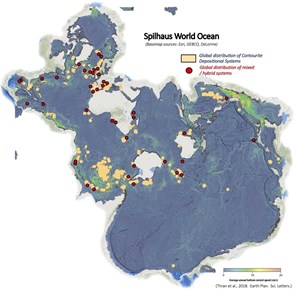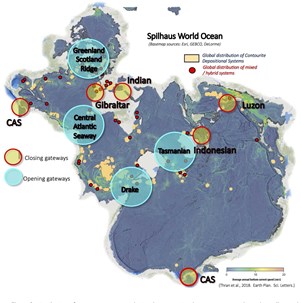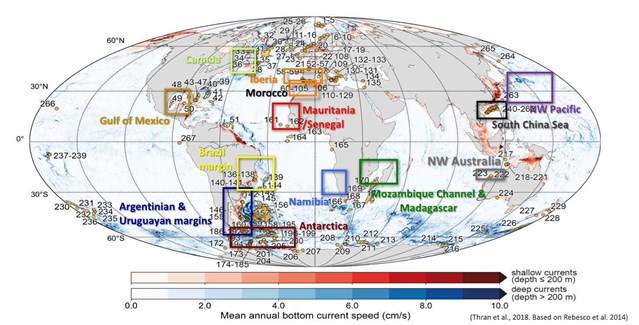
The group focuses on deep-marine sedimentation and the influence of bottom-current circulation along continental margins and adjacent abyssal plains and their conceptual and societal impact.
This group is currently internationally leading this area of research. The results and deliverables of contourites and mixed (turbidites + bottom current) depositional systems have strong scientific and economic impacts, and group members routinely collaborate with high-profile industry partners.
So far our research has focussed on:
- Seismic characteristics on contourites and mixed systems
- Sedimentologic and ichnological characteristics of contourites and mixed systems
- Modern processes immediately above the sea floor (the benthic boundary layer)
- Contourites and mixed depositional systems distribution in geological time (Fig 1)
- Reconstruct the global bottom-current circulation (Mesozoic & Cenozoic)
- Plate tectonics reconstructions with paleoceanographic / climate reconstructions
- Oceanic gateways & paleoceanograhic changes (Fig 2)
- Integrate studies of deep marine environments with numerical modelling data
- Bottom currents, contourites & geohazards
- Economic significance of contourites and mixed systems on geosciences applied to energy transition (CO2 sequestration and storage & hydrocarbon exploration)
- Societal implications
Figure 1 and 2 from Hernández-Molina, F.J. et al 2022. Chapter 9: Contourites and mixed depositional systems: a paradigm for deepwater sedimentary environments. In: Deep-Water Depositional Systems. (Eds.: Rotzien, J.R., Yeilding, C., Sears, R., Catuneanu, O., Hernández-Molina, F.J.,). Elservier. In press. Available on May/June 2022
Study areas:
a) Offshore study areas investigated over the last five years
b) Ancient / stratigraphic examples investigated in outcrop during the last years
- Morocco (Rifian corridor, late Miocene)
- Cyprus (Eocene to late Miocene)
- Cadiz (late Miocene)
- Angola (Eocene to Miocene)
- Java (Late Miocene - Pliocene)
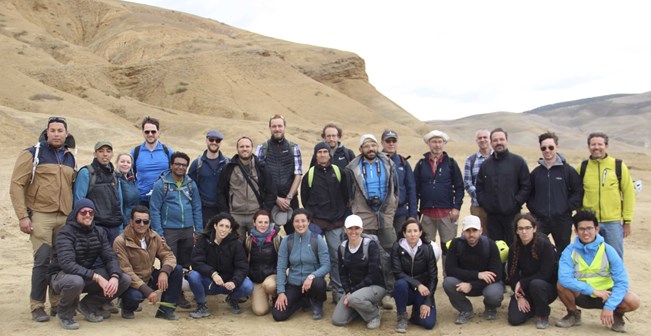 |
| Participants of the 2nd JIP#1 Annual Meeting (October 2019, Fes, Morocco). Sandy contourite deposits in the background. |
The group is developing successful research collaborations with other top-ranked research centres in the field in the UK, Europe and worldwide and has had significant and sustained impact on knowledge transfer in the discipline as well as through research projects and public engagements.
Follow us in Twitter: @DriftersRHUL
“The Drifters” research group organise regular (every 2-3 weeks) discussion meetings, The Drifters “Virtual Get-Together, VGT) sharing series”, about deepwater sedimentation and bottom-current processes and deposits.
Joint Industry Project (JIP)
“The Drifters Research Group” routinely collaborates with high-profile industry partners who fund much of our cutting-edge work.
1ST PHASE OF THE JIP (JIP#1) 2017-2022
Seismic recognition and sediment characterisation of deep-water contourites and reworked turbidites deposits
The first phase of the Join Industry Project (JIP#1) – Contourites translated existing academic understanding of contourite systems into the petroleum exploration domain and filled in gaps in scientific understanding. This phase began in November 2017 and ended in August 2022 (originally ended in 2020 but it was extended due to the COVID situation). It formalised the following criteria for identification of contourite deposits thereby constrained conceptual models and economic implications of these deposits. Sponsors for the first phase included six large international companies. Funding supported data collection, interpretation, and educational / training activities (e.g. graduate student funding). JIP#1 occurred as part of the “The Drifters” Research Group.
- Launch date: end of 2017.
- End date: August 2022
Funded by TOTAL, ENI, BP, ExxonMobil, Wintershall and Spectrum/TGS
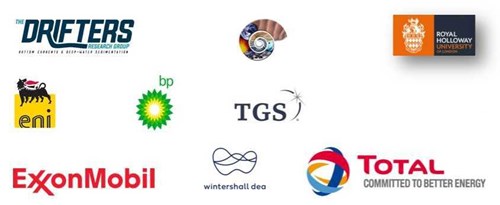
Scientific deliverables from JIP#1
Studied topics and students directly funded (or associated) to the JIP#1.
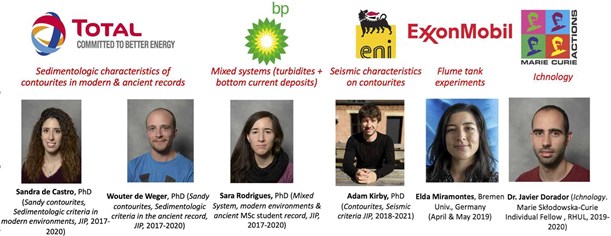 |
Publications directly linked to and funded by JIP#1 between 2018 to May 2022:
- 39 papers in international journals of Citation Reports, Science Citation Index (SCI)= 4 in 2018; 6 in 2019; 8 in 2020; 13 in 2021 and 8 until May 2022 (Other 10 papers very related but not directly funded by the JIP#1).
- 1 Chapter in an international book in 2022. Compilation on Contourites and Mixed Systems based on the JIP#1’ results
- 4 manuscripts submitted in 2022 to international journal of SCI. Another 2 currently in preparation;
- 46 contributions to international conferences= 15 in 2018; 26 in 2019, 2 in 2020, 2 in 2021 and 1 in 2022.
- 2 Outstanding Student Poster Awards: Sara Rodrigues (IAS, Rome 2019) & Wouter de Weger (MARID VI, Bremen 2019)
- 4 Thesis: 3 theses in 2021 and 1 in 2022
2ND PHASE OF THE JIP (JIP#2) 2022/2023-2026
Deep-water contourites and mixed deposits: criteria, global stratigraphic distribution and implications for reservoir modelling
After the great success of the 1st Joint Industry Project JIP#1 (Contourites) we are launching the JIP#2.
This second phase of the Join Industry Project (JIP#2) – Contourites and hybrid depositional systems will continue to refine criteria for identifying contourites and hybrid depositional systems. It will evaluate their role on sedimentary basin evolution and implications for reservoir modelling. JIP#1 focussed on how to identify contourites but JIP#2 seeks to answer the questions of exactly when and why these two types of sedimentary systems appear in the sedimentary record. This research will be administered by The Drifters Research Group led by Professor F. Javier Hernandez-Molina as joint Principal Investigator. The Drifters Research Group has already made major scientific contributions to understanding of deep-water marine processes and routinely collaborates with industry partners.
Summary of the JIP (JIP#2) - PDF download

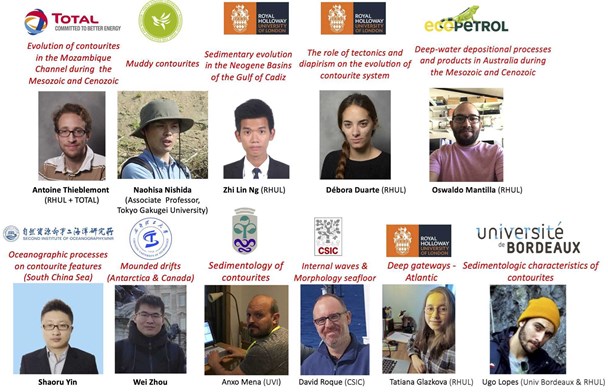 |
Students
- Adam Kirby, PhD (Seismic criteria for identifying contourites, JIP, 2018-2023)
- Arwed Gibb, Post-Doc (Microfacies, Eocene-Oligocene calcareous contourites, Cyprus, Greifswald Univ., 2019-2023)
- David Roque. Ondas internas en el Golfo de Cadiz: Implicaciones oceanográficas y morfosedimentarias (2020-2022, Univ Cadiz, Spain & RHUL, UK).
- Debora Duarte, PhD (Tectonic evolution in the Gulf of Cadiz from late Miocene to the present and its influence on contourite deposition, FCT Fellow, 2017-2022)
- Tatiana Glazkova, MRes (Decoding deep marine circulation: a case study of three deep marine gaps/gateways in the NE Atlantic. 2021-2024)
- Thameem Mulakkampilly Shamsudeen, MSc (Late Miocene sedimentary evolution of the Morocco continental margin, RHUL, 2022)
Previous Students
2022. Erl Joshua Taylan. MSc (Early Cretaceous clinothem features of NW Australia, RHUL, 2021)
2021. Samuel Stocker. MSc (Evolution of a Messinian turbiditic depositional system in the deep Algarve Basin: implications for hydrocarbon exploration and carbon capture and storage, RHUL, 2021)
2021-2022. Gijsbert Anne van Dijk. MRes (Paleoenvironmental changes at the Miocene/Pliocene boundary in the Sicilian Caltanissetta Basin: a sedimentological study, RHUL & Utrecht University, The Netherland, 2022)
2020. Jaspreet Kaur. MSc (Late Miocene turbidite depositional system in the Deep Algarve Basin, northern Gulf of Cadiz: conceptual and economic implications, RHUL, 2020)
2020-2021. Dr. Javier Dorador (Ichnological analysis of core and outcrop contourite facies: scientific and economic implications (ICON-SE). EU-funded Marie Curie IF (Individual Fellow)
2019. Dr. Wei Zhou (A comparative study of the South Orkney Microcontinent (Antarctica) and offshore Newfoundland (Canada). Chengdu University of Technology, China)
2019. Dr. Shaoru Yin (Contourite features along the South China Sea. Second Institute of Oceanography, Ministry of Natural Resources, China)
2019. Alex Mason, PhD (Paleostraits, South Italy. RHUL, 2017-2019)
2019-2021. Tanya Glazkova. MRes (Deep sea sedimentation in the Discovery Gap (NE Atlantic) during the Quaternary, RHUL, 2021)
2019-2020. Dr. Javier Dorador (Ichnological analysis of core and outcrop contourite facies: scientific and economic implications. (Newton International Fellow (NF170111)
2019-2020. Chantal de Savigny-Bower. MRes (Evolution of the Northern Morocco continental margin during the Late Miocene to the Quaternary, RHUL, 2020)
2018. Thomas Howlett. MSc (Cenozoic deep water seismic facies associations in the Northern Carnarvon Basin, NW Australia. RHUL, 2018)
2018. Robert Morgan. MSc (Contourites features, offshore Namibia, RHUL, 2018)
2018. Oscar Felipe Marin Castaño. MSc (Sedimentary evolution through the Cretaceous in the Northern Carnarvon Basin, NW Australia. RHUL, 2018)
2018. Adrien Mergnat. MSc (Contourites features, offshore Madagascar, RHUL, 2018)
2018-2022. Oswaldo Mantilla, PhD (Deep-water depositional processes & products in the Northern Carnarvon Basin (NW Australia), Funded by Ecopetrol, 2018-2022)
2018-2019. Nicholas Belcher, MRes (Bedfoms and trace fossils, GRACO project, Gulf of Cadiz. 2018-2019)
2018-2019. Kishore Thamilselvan. MSc (Sedimentological and Compositional Analysis of Mixed Siliciclastic-Carbonate Sediments, Gulf of Cádiz, Spain. RHUL, 2021)
2017. Zhi Lin Ng. MSc (Contourites in the Agios Konstantinos and Petra Tou Romiou sections, Lefkara and Pakhna Formations, Cyprus: Conceptual and economic consideration. RHUL, 2017)
2017. Leona Hyslop. MSc (Gravitational Processes & Products along Contourite Terraces in the Uruguayan margin during the Palaeogene & Neogene. Theoretical implications on Hydrocarbon Exploration. RHUL, 2017)
2017. Joe Killen. MSc (Regional assessment of lithological variations within the Eagle Ford Shale, Gulf of Mexico, implications for unconventional reservoirs. RHUL, 2017)
2017. Dr. Shaoru Yin (Sediment drift formation by Mesoscale eddies on the continental slope of the northeastern South China Sea. Second Institute of Oceanography, Ministry of Natural Resources, China)
2017. Dr. Anxo Mena (Paleoceanographic reconstruction and sedimentary evolution of the contourite depositional systems generated by the MOW around Iberia: multy-proxy analysis from the Cantabrian and SW Iberian margins. University of Vigo, Spain).
2017. Adam Kirby. MSc (The development of contourites during the late Cretaceous on the West Iberian Margin and their conceptual application to a petroleum system. RHUL, 2017)
2017-2022. Ng Zhi Lin, PhD (Sedimentary evolution in the Gulf of Cadiz from late Miocene to the present, Funded by RHUL, 2018-2022)
2017-2021. Wouter De Weter, PhD (Sedimentological characteristics of a late Miocene Contourite Channel System, Funded by JIP#1, 2017-2021)
2017-2021. Sara Rodrigues, PhD (Sedimentary model for mixed depositional systems: Conceptual and economic implications, Funded by JIP#1, 2017-2021)
2017-2021. Sandra De Castro Santos, PhD (Modern Sandy Contourites: Conceptual and economic implications, Funded by JIP#1, 2017-2021)
2016. Sataphon Suklap. MSc (Microfacies Analysis of Turbidites and Sandy Contourites from the Lefkara Formation (Cyprus): Sedimentary Characteristics and implication as reservoir, RHUL, 2016)
2016. Jun Sasamura. MSc (Late Miocene to Present Sedimentary Stacking Pattern in the Algarve Basin (south of Portugal): Implications on Hydrocarbon Exploration, RHUL, 2016)
2016. Jamie Beagle. MSc (Late Miocene – Present stratigraphic evolution of the Alentejo Basin (SW Portugal): conceptual implications on hydrocarbon exploration. RHUL, 2016)
2016. Dr. Elda Miramontes (Bottom current processes and products in the Western Mediterranean Sea: sedimentary and paleoceanographic implications. IFREMER, France).
2016. Brian Docherty. MSc (From hemipelagic deposits through silty to coarse grained sandy calcareous contourites (Lefkara Fm. Cyprus): implication for HC exploration, RHUL, 2016)
2016-2020. Antoine Thieblemont, PhD (Contourite depositional and erosional features on the Mozanbique, Namibia and Uruguayan Margin: Implications for hydrocarbon exploration, Funded by TOTAL, 2016-2020)
2016-2017. Edwards Evans, MRes (Analysis of quarts grains on sandy contourite deposits in the Gulf of Cadiz: sedimentological implications. 2016-2017)
2015. Valini Kisson. MSc (Stratigraphic and tectonic evolution of the northern Gulf of Cádiz, RHUL, 2015)
2015. Scott Campbell. MSc (Sedimentary stacking pattern from the Eocene and Oligocene in the Uruguayan Margin, RHUL, 2015)
2015-2016. Claudia Jons, MRes (Sandy contourite deposits in the Gulf of Cadiz: sedimentological aspects and its evolutionary implication with the Gibraltar Gateway. 2015-2016)
2014. Abdulai Salifu Nantogmah. MSc (Middle Miocene to present evolution of the Punta Del Este Basin, Uruguay Margin, RHUL, 2014)
2014-2018. Adam Creaser, PhD (Contourites, Late Cretaceous, Uruguayan Continental Margin, Funded by BG, 2014-2018)
Researcher and key collaborators
Adolfo Maestro (IGME, Spain)
Adriano R. Viana (Petrobras, Brazil)
Alvaro Arnaiz (Repsol)
Alvaro, Jimenez Berrocoso (Repsol, Spain)
Amine Manar Mohamed (ONHYM, UK)
Antoine Thieblemont (France)
Anxo Mena (Sedimentology, paleoceanography, Univ. Vigo / RHUL, 2017-2020)
Ashley Clarke (BP, UK)
Calvin Campbell (Geological Survey of Canada-Atlantic Lands and Minerals Sector, Canada)
Carlota Escutia (CSIC, Granada, Spain)
Cirilo Cauxeiro (ISPTEC, Univ. Luanda, Angola)
Claus-Dieter Hillenbrand (BAS, UK)
Cristina Roque (EMEPC / IDL –Instituto D. Luiz, Lisbon, Portugal)
David Roque (CSIC, Spain)
David Van Rooij (Ghent University, Gent, Belgium)
David Waltham (RHUL, UK)
De Santa Ana Héctor (ANCAP, Uruguay)
Dmitry Borisov (Shirshov Institute of Oceanology, Russia).
Domenico Chiarella (RHUL, UK)
Elda Miramontes (Bremen Univ, Germany)
Eleanor J. Stirling (BP, UK)
Emmanuelle Ducassou Univ. Bordeaux, France)
Estefania Llave (IGME, Madrid, Spain)
Evgenia Dorokhova (Shirshov Institute of Oceanology, Russia)
Fernando Bohoyo (IGME, Madrid, Spain)
Francisco J. Lobo (IACT, Spain)
Francisco J. Jiménez Espejo (CSIC, Granada, Spain)
Francisco J. Rodríguez-Tovar (Univ. Granada, Spain)
Francisco J. Sierro (Univ. Salamanca, Spain)
François Raisson (TOTAL SA, France)
Giancarlo Davoli (ENI, Italy)
Gianluca Badalini (Shell, UK)
Gristo Pablo (ANCAP, Uruguay)
Guillermo Frances (Univ. Vigo, Spain)
Héctor de Santa Ana (ANCAP, Uruguay)
Heiko Huneke (Universität Greifswald, Germany)
Hugo Matias (Univ Lisbon, Portugal)
Jaspreet Kaur (2019)" <JaspreetKaur.2019@live.rhul.ac.uk>,
Javier Dorador (Univ. Granada, Spain)
Jon Rotzien (Basin Dynamics LLC & University of Houston, USA).
Joris T. Eggenhuisen (Utrecht Univ., The Netherland)
Jose.Torres-Escamez (Shell, The Netherland)
Juan Fedele (ExxonMobil Upstream Research Company, Houston, Texas, USA)
Karyna Rodriguez (Searcher, Woking, UK)
Lara F. Pérez (GEUS, Geological Survey of Denmark and Greenland)
Luis Miguel Fernández-Salas (IEO, Spain)
Marco Fonnesu (Eni SpA Upstream and Technical Services, Milano, Italy)
Marco Fonnesu (ENI, Italy)
Marga García (CSIC, Granada, Spain)
Markus Mohr (Wintershall Dea, Germany)
Marta Pérez-Arlucea (Univ. Vigo, Spain)
Michele Rebesco (OGS, Italy)
Miguel Bruno (Univ. Cadiz, Spain)
Neil Hodgson (Searcher, Woking, UK)
Ng Zhi Lin (UK)
Nicola Scarselli (RHUL, UK)
Nicole J Bayliss (ExxonMobil Upstream Research Company, Houston, Texas, USA)
Oscar Marin Castano (Ecopetrol)
Oswaldo Mantilla, (Ecopetrol, Colombia)
Philip Thompson (Shell, UK)
Rachel Brackenridge (Heriot-Watt University, Edinburgh, UK)
Rachel Flecker (University of Bristol, Bristol, UK)
Rachel, Brackenridge (Aberdeen Univ, UK)
Rene Winter (BP, UK)
Ricardo F. Sánchez Leal (IEO, Spain)
Robert Larter (BAS, UK)
Sandra De Castro Santos (Arquimea)
Santiago Ledesma (Naturgy, Spain)
Sara Rodrigues (Portugal)
Shan Liu (School of Marine Science, Zhuhai, China)
Shaoru Yin (Second Institute of Oceanography, Ministry of Natural Resources, Hangzhou, China)
Vadim V. Sivkov (Shirshov Institute of Oceanology, Russian Academy of Sciences)
Wei Zhou (Chengdu Univ. Technology, Chengdu, China).
Wout Krijgsman (Utrecht Univ., The Netherland)
Wouter De Weter, (The Netherland)
Xiaoxia Huang (Institute of Deep-sea Science and Engineering, China)
Research associated projects
Research associated Projects
Project INPULSE
INPULSE is studying how Mediterranean Outflow Water (MOW) is affecting the seafloor, bedforms, type of substrate and associate habitats in the Gulf of Cadiz.
Download the interactive PDF here.
Project SCORE
SCORE is searching the sedimentary facies in sandy deposits drilled in the IODP 339 in the Gulf of Cadiz
Project TASDRACC
The TASDRACC Project is searching the tectonic and oceanographic events involved in the development of the Antarctic Circumpolar Current (ACC) and their links to paleoclimate and ice sheet evolution records
IMMAGE. IODP-895 + ICDP.
Amphibious Propossal IMMAGE. Investigating Miocene Mediterranean-Atlantic Gateway Exchange.
IODP-732
Sediment drifts off the Antarctic Peninsula and West Antarctica.
Selection of recent references
Capella, W., Hernández-Molina, F.J., Flecker, R., Hilgen, F.J., Hssain, M., Kouwenhoven, van Oorschot, M., Sierro, F.J., Stow, D.A.V., Trabucho-Alexandre, J., Tulbure, M.A., Yousfi, M.Z., Krijgsman, W., 2017. Sandy contourite drift in the late Miocene Rifian Corridor (Morocco): Reconstruction of depositional environments in a foreland-basin seaway. Dev. Sedimentology, 355, 31–57.
de Castro, S., Hernández-Molina, F.J., de Weger, W., Jimenez-Espejo, F.J., Rodríguez- Tovar, F.J., Mena, A., Llave, E., Sierro, F.J., 2021. Contourite characterization and its discrimination from other deep-water deposits in the Gulf of Cadiz contourite depositional system. Sedimentology, 68 (3) 987-1027. https://doi.org/10.1111/sed.12813
de Weger, W., Hernández-Molina, F.J., Miguez-Salas, O., de Castro, S., Bruno, M., Chiarella, D., Sierro, F.J., Blackbourn, G., Manar, M.A., 2021. Contourite depositional system after the exit of a strait: Case study from the late Miocene South Rifian Corridor, Morocco. Sedimentology, 68 (7): 2996-3032 https://doi.org/10.1111/sed.12882
Glazkova, T., Hernández-Molina, F.J., Dorokhova, E., Mena, A., Roque, C., Rodriguez-Tovar, F.J., Krechik, V., Kuleshova, L., Llave, E., 2022. Sedimentary processes in the Discovery Gap (Central–NE Atlantic): An example of a deep marine gateway. Deep Sea Research Part I, 180, 103681, https://doi.org/10.1016/j.dsr.2021.103681
Hernández-Molina, F.J., Campbell, S., Badalini, G., Thompson, P., Walker, R., Soto, M., Conti, B., Preu, B., Thieblemont, A., Hyslop, L., Miramontes, E., Morales, E., 2018. Large bedforms on contourite terraces: Sedimentary and conceptual implications. Geology, 46 (1), pp.. https://doi.org/10.1130/G39655.1.
Hernández-Molina, F.J., de Castro, S., de Weger, W., Duarte, D., Fonnesu, M, Glazkova, T., Kirby, A., Llave, E., Ng, Z.L., Mantilla Muñoz, O., Rodrigues, S., Rodríguez-Tovar, F.J., Thieblemont, A., Viana, A., Yin, S., 2022. Chapter 9: Contourites and mixed depositional systems: a paradigm for deepwater sedimentary environments. In: Deep-Water Depositional Systems. (Eds.: Rotzien, J.R., Yeilding, C., Sears, R., Catuneanu, O., Hernández-Molina, F.J.,). Elservier. In press. Available on May 2022
Hernández-Molina, F.J., Llave, E., Sierro, F.J., Roque, C., Van der Schee, M., Williams, T., Ledesma, S., Arnais, A., Rosales, C., Brackenridge, R.E., Stow, D.A.V., 2016. Evolution of the Gulf of Cadiz Margin and west Portugal contourite depositional system: tectonic, sedimentary and paleoceanographic implications from IODP Expedition 339. Marine Geology, 377: 7-39. https://doi.org/10.1016/j.margeo.2015.09.013
Hüneke, H., Hernández-Molina, F., Rodrıguez-Tovar, F., Llave, E., Chiarella, D., Mena, A., Stow, D., 2020. Diagnostic criteria using microfacies for calcareous contourites, turbidites and pelagites in the Eocene-Miocene slope succession, southern Cyprus. Sedimentology. https://doi.org/10.1111/sed.12792
Kirby, A., Hernández-Molina, F.J., Rodrigues, S., 2021. Lateral migration of large sedimentary bodies in a deep-marine system offshore of Argentina. Scientific Reports. 11, 20291. https://doi.org/10.1038/s41598-021-99730-x
Mantilla., O., Hernández-Molina, F.J., Scarselli, N., 2022. Can bottom currents create clinothems? An exceptional example of a large asymmetric mounded drift in the Late Jurassic-Early Cretaceous from NW Australia. Geology. Geology 50 (6):741-745. https://doi.org/10.1130/G50068.1
Miramontes, E., Eggenhuisen, J.T., Silva Jacinto, R., Poneti, G., Pohl, F., Normandeau, A., Campbell, D.C., Hernández-Molina, F.J., 2020. Channel-levee evolution in combined contour current–turbidity current flows from flume-tank experiments: Geology,v. 48, p., https://doi.org/10.1130/G47111.1
Ng, Z.L., Hernández-Molina, F.J., Ledesma, S., Sierro, F.J., Duarte, D., Llave, E., Roque, C., Arnáiz, A., 2022. Late Miocene evolution of the eastern Deep Algarve basin: Interaction of bottom currents and gravitational processes in a foredeep setting. Marine and Petroleum Geology, 141, 105695, https://doi.org/10.1016/j.marpetgeo.2022.105695.
Rebesco, M., Hernández-Molina, F.J., Van Rooij, D., Wåhlin, A., 2014. Contourites and associated sediments controlled by deep-water circulation processes: state of the art and future considerations. Mar. Geol. 352, 111–154. https://doi.org/10.1016/j.margeo.2014.03.011
Rodrigues, S., Deptuck, M.E., Kendell, K.L., Campbell, C., Hernández-Molina, F. J., 2022b. Cretaceous to Eocene mixed turbidite-contourite systems offshore Nova Scotia (Canada): spatial and temporal variability of down- and along-slope processes. Marine and Petroleum Geology, 138, 105572 https://doi.org/10.1016/j.marpetgeo.2022.105572
Rodrigues, S., Hernández-Molina, F.J., Fonnesu, M., Miramontes, E., Rebesco, M., Campbell, D.C., 2022c. A new classification system for mixed (turbidite-contourite) depositional systems: Examples, conceptual models and diagnostic criteria for modern and ancient records. Earth-Science Reviews, 104030. https://doi.org/10.1016/j.earscirev.2022.104030.
Rodrigues, S., Hernández-Molina, F.J., Hillenbrand, C.-D., Lucchi, R.G., Rodríguez-Tovar, F.J., Rebesco, M., Larter, R.D., 2022a. Recognizing key sedimentary facies and facies associations in mixed depositional systems: the case of the Pacific margin of the Antarctic Peninsula. Sedimentology. https://doi.org/10.1111/sed.12978
Rodríguez-Tovar, F.J., Hernández-Molina, F.J., 2018. Ichnological analysis of contourites: Past, present and future (2018) Earth-Science Reviews, 182, pp. 28-41. https://doi.org/10.1016/j.earscirev.2018.05.008
Rodríguez-Tovar, F.J., Hernández-Molina, F.J., Hüneke, H., Llave, E., Stow, D., 2019. Contourite facies model: Improving contourite characterization based on the ichnological analysis. Sedimentary Geology, 384, pp. 60-69. https://doi.org/10.1016/j.sedgeo.2019.03.010
Rotzien, J.R., Yeilding, C., Sears, R., Hernández-Molina, F.J., Catuneanu, O., Eds., 2022. Deepwater sedimentary systems: sciences, discovery and implications. Elsevier. In press. Available on May 2022. ISBN: 9780323919180. https://www.elsevier.com/books/deep-water-depositional-systems/rotzien/978-0-323-91918-0
Thiéblemont, A., Hernández-Molina, F.J., Miramontes, E., Raisson, F., Penven, P., 2019. Contourite depositional systems along the Mozambique channel: The interplay between bottom currents and sedimentary processes. Deep-Sea Research Part I: Oceanographic Research Papers, 147, pp. 79-99. https://doi.org/10.1016/j.dsr.2019.03.012
Thiéblemont, A., Hernández-Molina, F.J., Ponte, J.-P., Robin, C., Guillocheau, F., Cazzola, C., Raisson, F., 2020. Seismic stratigraphic framework and depositional history for Cretaceous and Cenozoic contourite depositional systems of the Mozambique Channel, SW Indian Ocean. Mar. Geol. 425, 106192. https://doi.org/10.1016/j.margeo.2020.106192.
Yin, S., Hernández-Molina, F.J., Miramontes, E., Shen, Z., Yang, C., Gao, J., Liu, S., Li, J., 2022. Bedforms in a mixed (turbidite-contourite) system in the Cosmonaut Sea continental rise, Antarctica. Geomorphology, 140, https://doi.org/10.1016/j.geomorph.2022.108287
Yin, S., Hernández-Molina, F.J., Zhang, W., Li, J., Wang, L., Ding, W., Ding, W., 2019. The influence of oceanographic processes on contourite features: A multidisciplinary study of the northern South China Sea. Marine Geology, 415, 105967 https://doi.org/10.1016/j.margeo.2019.105967









